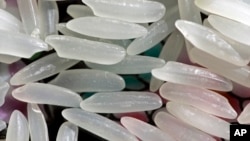The United States Food and Drug Administration has tested 1,300 samples of rice and rice products for the presence of arsenic, a toxic chemical element that is naturally found in soil. The U.S. regulatory agency is trying to determine whether levels of arsenic present in rice, a food staple for billions for people all over the world, poses a public health risk.
FDA scientists tested the samples for levels of both organic and inorganic arsenic, the most toxic form of the chemical. They found the average levels of organic arsenic ranged from 2.6 to 7.2 micrograms per serving, with instant rice at the low end and brown rice at the high end of the range.
For inorganic arsenic, scientists found rice and rice products contain between .1 to 6.6 micrograms, with the lowest amount in infant formula and the highest levels of the toxic substance in rice pasta. A microgram is one-millionth of a gram. Serving sizes vary.
FDA officials say products containing arsenic are difficult to avoid because the toxic chemical element is distributed throughout Earth’s crust, both in soil and water. Rice is particularly vulnerable to contamination because it is grown in water, taking up arsenic through its roots.
The burning of fossil fuels, mining and the use of pesticides containing arsenic have also added to the contamination problem. But even if all human activities were eliminated, arsenic would still be present in foods, according to FDA officials.
The FDA’s Center for Safety and Applied Nutrition will now analyze the risk to humans of eating arsenic contaminated rice and rice products, and ways to limit harm to vulnerable populations, including children and pregnant women.
FDA scientists tested the samples for levels of both organic and inorganic arsenic, the most toxic form of the chemical. They found the average levels of organic arsenic ranged from 2.6 to 7.2 micrograms per serving, with instant rice at the low end and brown rice at the high end of the range.
For inorganic arsenic, scientists found rice and rice products contain between .1 to 6.6 micrograms, with the lowest amount in infant formula and the highest levels of the toxic substance in rice pasta. A microgram is one-millionth of a gram. Serving sizes vary.
FDA officials say products containing arsenic are difficult to avoid because the toxic chemical element is distributed throughout Earth’s crust, both in soil and water. Rice is particularly vulnerable to contamination because it is grown in water, taking up arsenic through its roots.
The burning of fossil fuels, mining and the use of pesticides containing arsenic have also added to the contamination problem. But even if all human activities were eliminated, arsenic would still be present in foods, according to FDA officials.
The FDA’s Center for Safety and Applied Nutrition will now analyze the risk to humans of eating arsenic contaminated rice and rice products, and ways to limit harm to vulnerable populations, including children and pregnant women.





